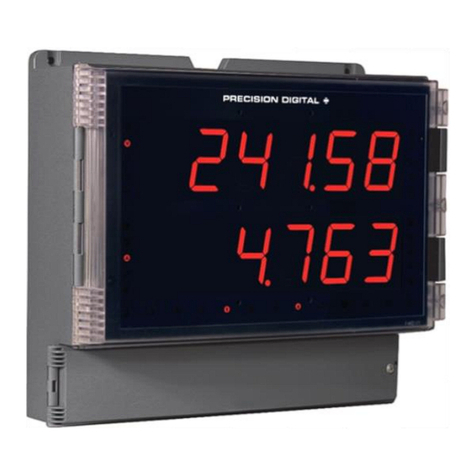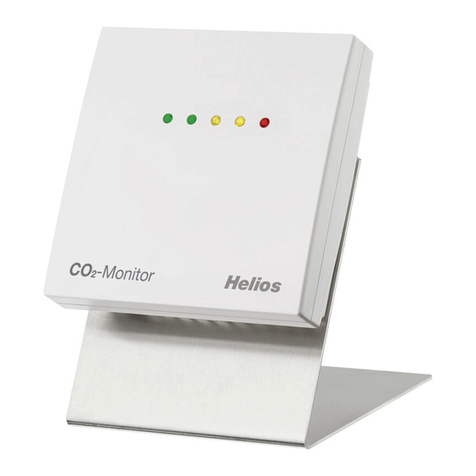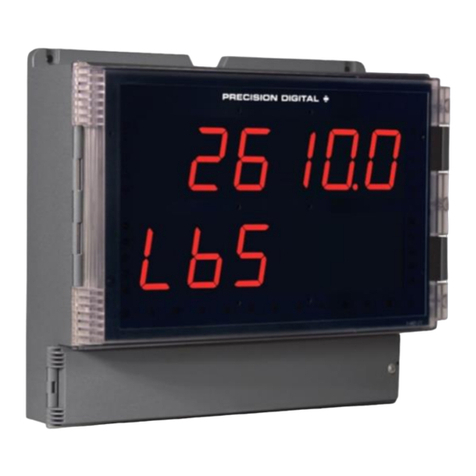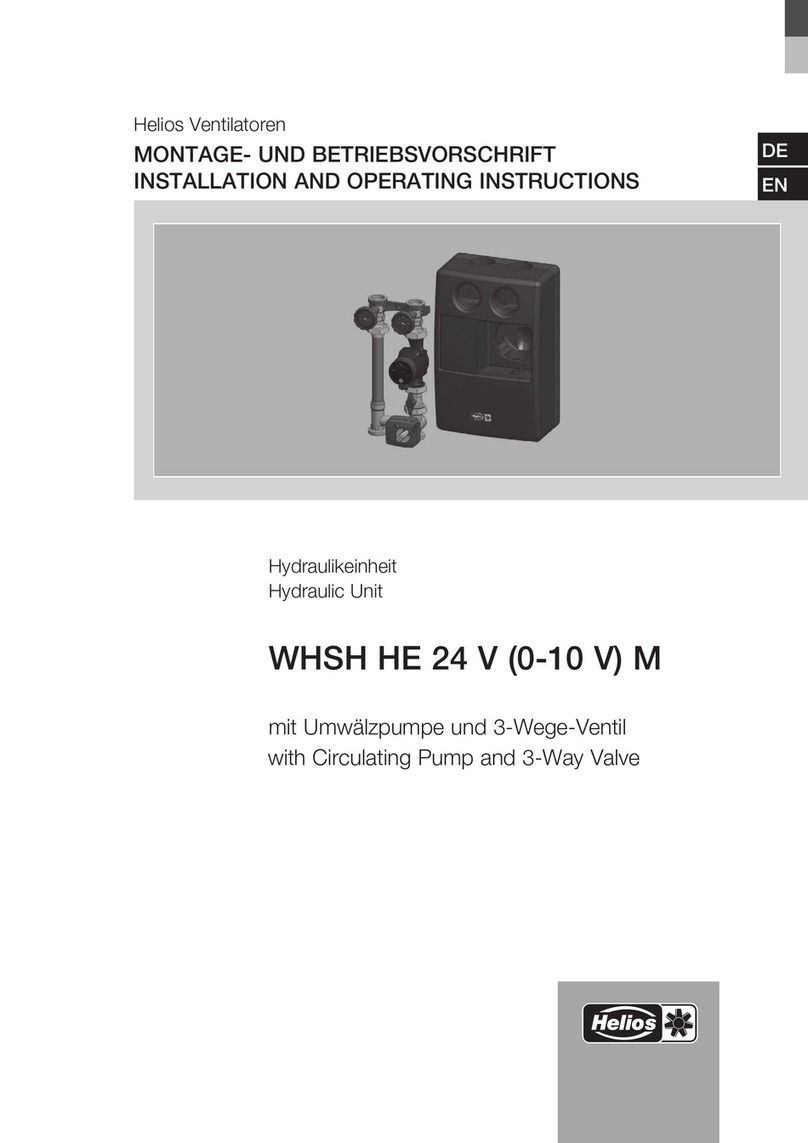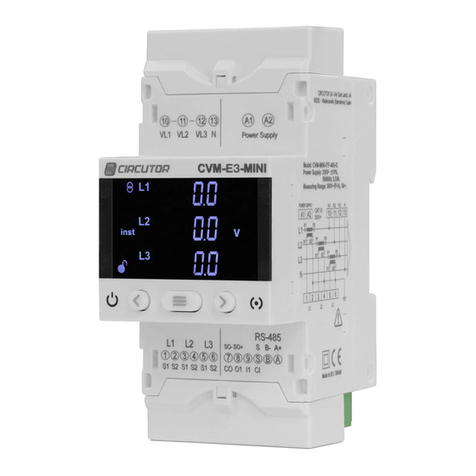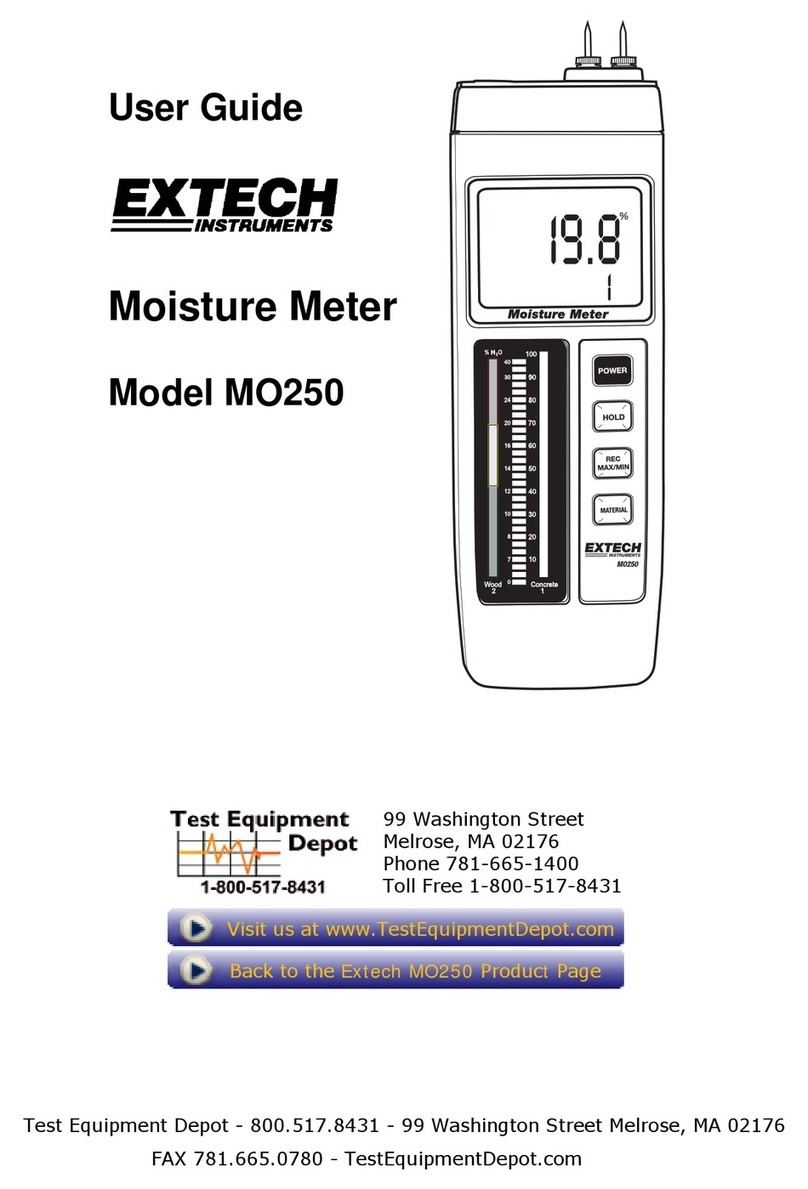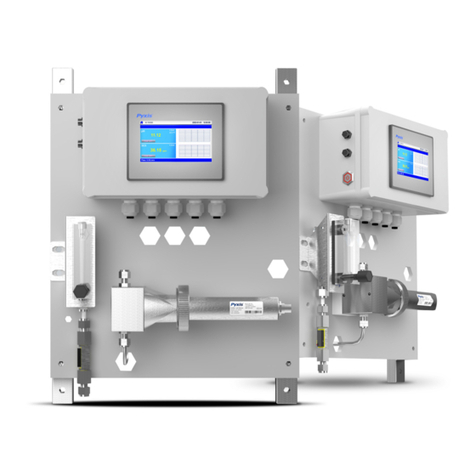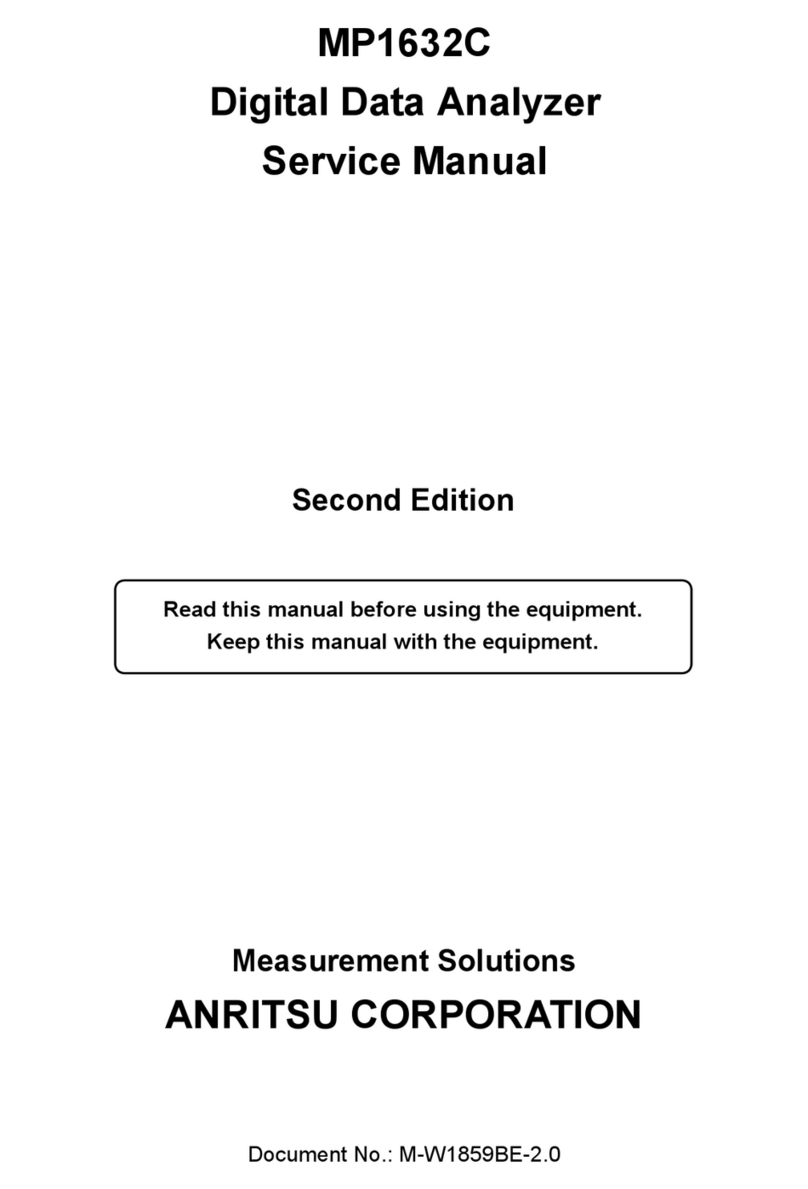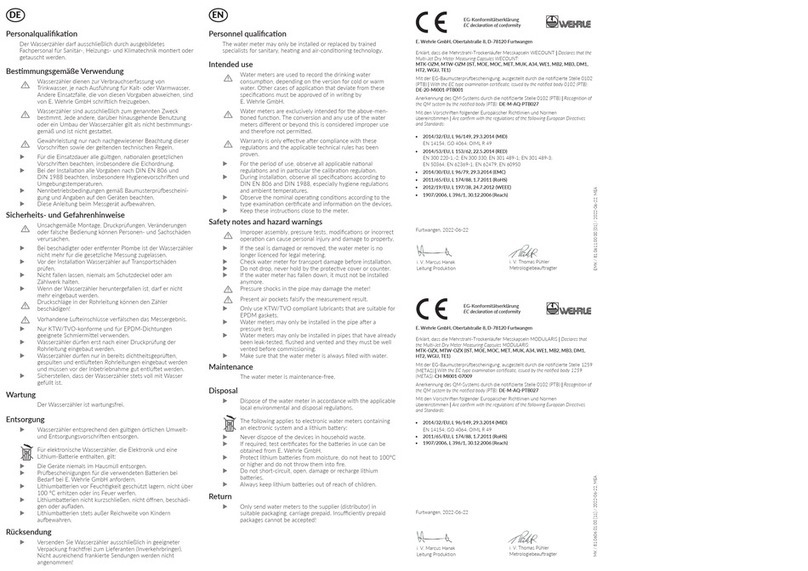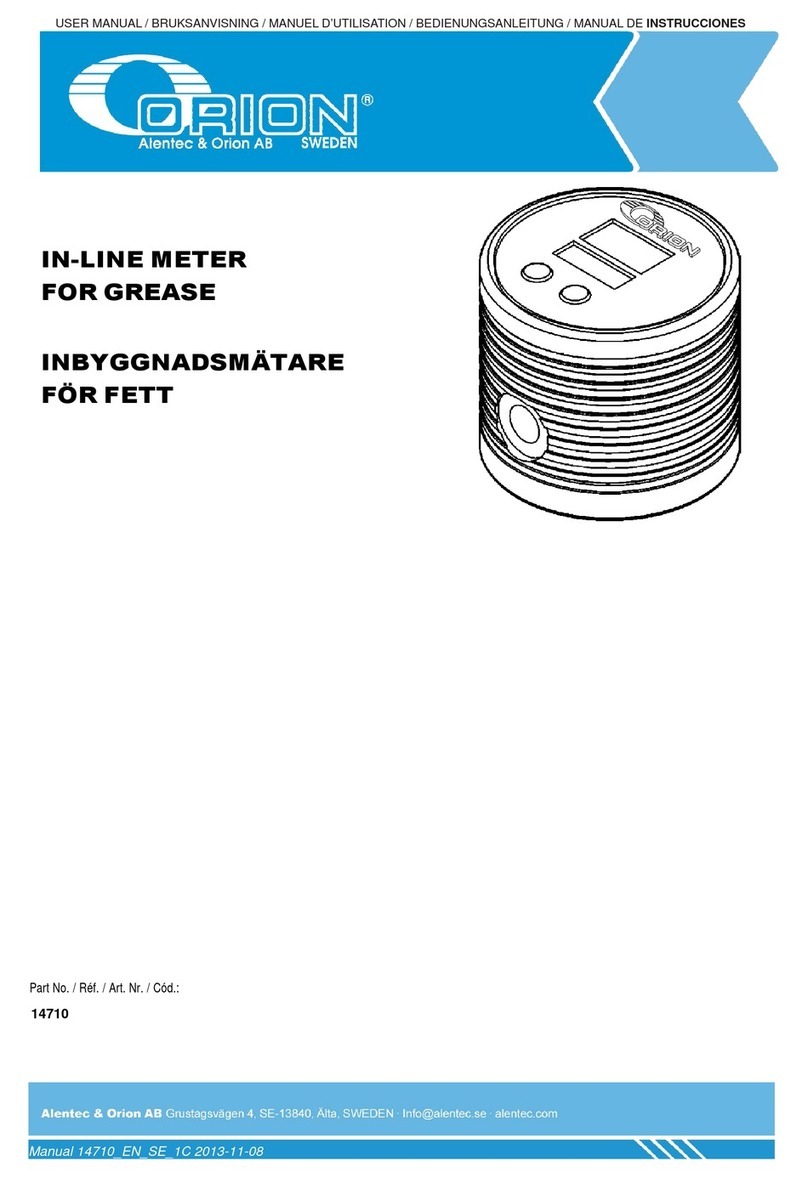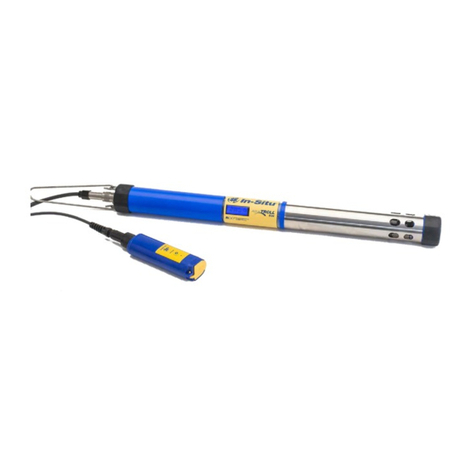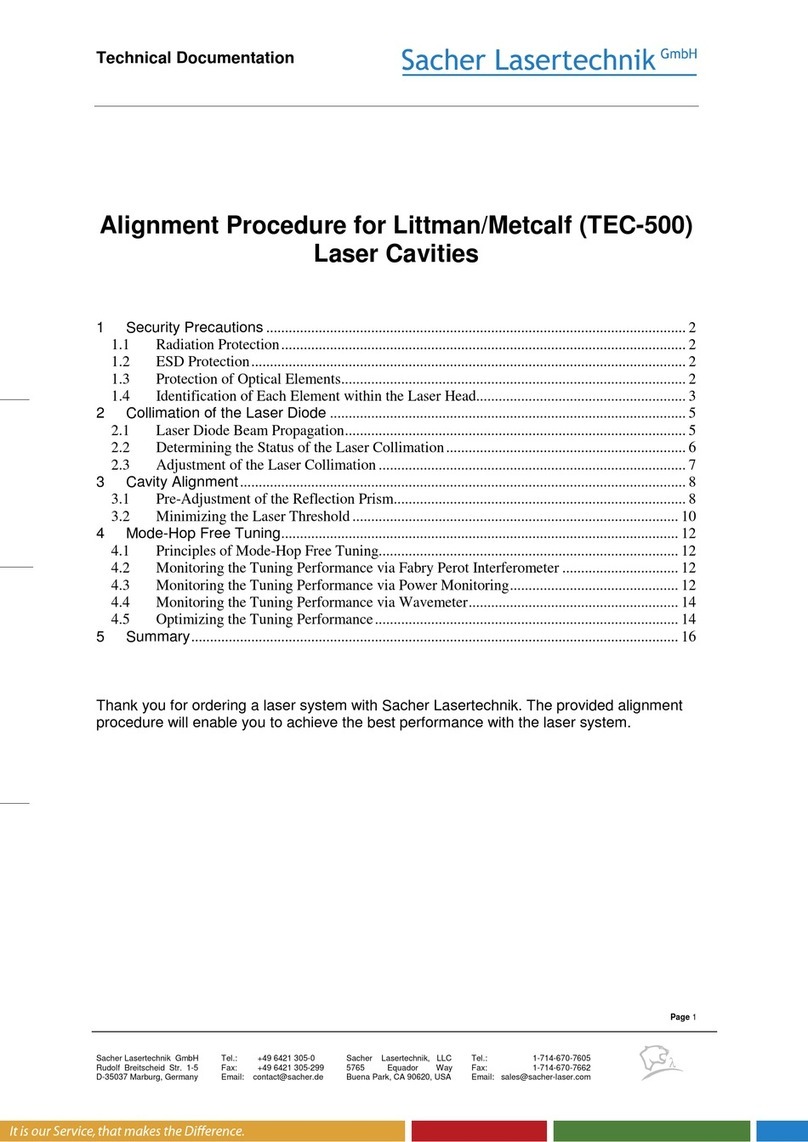Helios LZD Series User manual

Überwachungseinheit für Wälzlager
Lager-Zustandsdiagnostik
LZD...
D
Helios Ventilatoren
MONTAGE- UND BETRIEBSVORSCHRIFT NR. 85 894

nhaltsverzeichnis
KAP TEL 1. ALLGEME NE H NWE SE . . . . . . . . . . . . . . . . . . . . . . . . . . . . . . . . . . . . . . . . . . . . . . . . . . . . . . . . . .Seite 1
1.0 Wichtige nformationen . . . . . . . . . . . . . . . . . . . . . . . . . . . . . . . . . . . . . . . . . . . . . . . . . . . . . . . . . . . . . . . . .Seite 1
1.1 Warnhinweise . . . . . . . . . . . . . . . . . . . . . . . . . . . . . . . . . . . . . . . . . . . . . . . . . . . . . . . . . . . . . . . . . . . . . . . .Seite 1
1.2 Sicherheitshinweise . . . . . . . . . . . . . . . . . . . . . . . . . . . . . . . . . . . . . . . . . . . . . . . . . . . . . . . . . . . . . . . . . . . .Seite 1
1.3 Garantieansprüche und Haftungsausschluss . . . . . . . . . . . . . . . . . . . . . . . . . . . . . . . . . . . . . . . . . . . . . . . . .Seite 2
1.4 Vorschriften – Richtlinien . . . . . . . . . . . . . . . . . . . . . . . . . . . . . . . . . . . . . . . . . . . . . . . . . . . . . . . . . . . . . . . .Seite 2
1.5 Sendungsannahme . . . . . . . . . . . . . . . . . . . . . . . . . . . . . . . . . . . . . . . . . . . . . . . . . . . . . . . . . . . . . . . . . . . .Seite 2
1.6 Einlagerung . . . . . . . . . . . . . . . . . . . . . . . . . . . . . . . . . . . . . . . . . . . . . . . . . . . . . . . . . . . . . . . . . . . . . . . . . .Seite 2
1.7 Transport . . . . . . . . . . . . . . . . . . . . . . . . . . . . . . . . . . . . . . . . . . . . . . . . . . . . . . . . . . . . . . . . . . . . . . . . . . . .Seite 2
1.8 Personalqualifikation . . . . . . . . . . . . . . . . . . . . . . . . . . . . . . . . . . . . . . . . . . . . . . . . . . . . . . . . . . . . . . . . . . .Seite 2
1.9 Allgemeine Beschreibung . . . . . . . . . . . . . . . . . . . . . . . . . . . . . . . . . . . . . . . . . . . . . . . . . . . . . . . . . . . . . . .Seite 2
1.10 Allgemeine Beschreibung . . . . . . . . . . . . . . . . . . . . . . . . . . . . . . . . . . . . . . . . . . . . . . . . . . . . . . . . . . . . . . .Seite 2
1.11 Lieferumfang/Komponenten . . . . . . . . . . . . . . . . . . . . . . . . . . . . . . . . . . . . . . . . . . . . . . . . . . . . . . . . . . . . .Seite 2
KAP TEL 2. NSTALLAT ON/MONTAGE . . . . . . . . . . . . . . . . . . . . . . . . . . . . . . . . . . . . . . . . . . . . . . . . . . . . . . . . .Seite 3
2.0 nstallation . . . . . . . . . . . . . . . . . . . . . . . . . . . . . . . . . . . . . . . . . . . . . . . . . . . . . . . . . . . . . . . . . . . . . . . . . . .Seite 3
2.1 Allgemeine Bedingungen . . . . . . . . . . . . . . . . . . . . . . . . . . . . . . . . . . . . . . . . . . . . . . . . . . . . . . . . . . . . . . . .Seite 3
2.2 Gehäuseabmessungen . . . . . . . . . . . . . . . . . . . . . . . . . . . . . . . . . . . . . . . . . . . . . . . . . . . . . . . . . . . . . . . . .Seite 3
KAP TEL 3. ELEKTR SCHER ANSCHLUSS . . . . . . . . . . . . . . . . . . . . . . . . . . . . . . . . . . . . . . . . . . . . . . . . . . . . . .Seite 4
3.0 Elektrischer Anschluss . . . . . . . . . . . . . . . . . . . . . . . . . . . . . . . . . . . . . . . . . . . . . . . . . . . . . . . . . . . . . . . . . .Seite 4
3.1 Schaltplan SS-1089 . . . . . . . . . . . . . . . . . . . . . . . . . . . . . . . . . . . . . . . . . . . . . . . . . . . . . . . . . . . . . . . . . . .Seite 4
3.2 Übersicht des Anschlussbereichs . . . . . . . . . . . . . . . . . . . . . . . . . . . . . . . . . . . . . . . . . . . . . . . . . . . . . . . . .Seite 5
KAP TEL 4. NBETR EBNAHME . . . . . . . . . . . . . . . . . . . . . . . . . . . . . . . . . . . . . . . . . . . . . . . . . . . . . . . . . . . . . . .Seite 6
4.0 nbetriebnahme . . . . . . . . . . . . . . . . . . . . . . . . . . . . . . . . . . . . . . . . . . . . . . . . . . . . . . . . . . . . . . . . . . . . . . .Seite 6
4.1 Anzeige Systemstatus . . . . . . . . . . . . . . . . . . . . . . . . . . . . . . . . . . . . . . . . . . . . . . . . . . . . . . . . . . . . . . . . . .Seite 6
4.2 Funktionalität . . . . . . . . . . . . . . . . . . . . . . . . . . . . . . . . . . . . . . . . . . . . . . . . . . . . . . . . . . . . . . . . . . . . . . . . .Seite 6
4.3 ModbusRTU . . . . . . . . . . . . . . . . . . . . . . . . . . . . . . . . . . . . . . . . . . . . . . . . . . . . . . . . . . . . . . . . . . . . . . . . .Seite 7
4.4 Systembeschreibung zur Anbindung an die GLT . . . . . . . . . . . . . . . . . . . . . . . . . . . . . . . . . . . . . . . . . . . . . .Seite 7
4.5 Anbindung an den Computer für die erweiterte nbetriebnahme . . . . . . . . . . . . . . . . . . . . . . . . . . . . . . . . . .Seite 8
KAP TEL 5. TECHN SCHE DATEN . . . . . . . . . . . . . . . . . . . . . . . . . . . . . . . . . . . . . . . . . . . . . . . . . . . . . . . . . . . . .Seite 8
5.0 Technische Daten . . . . . . . . . . . . . . . . . . . . . . . . . . . . . . . . . . . . . . . . . . . . . . . . . . . . . . . . . . . . . . . . . . . . .Seite 8
KAP TEL 6. STÖRUNGSURSACHEN/WARTUNG . . . . . . . . . . . . . . . . . . . . . . . . . . . . . . . . . . . . . . . . . . . . . . . . .Seite 9
6.0 Störungsursachen . . . . . . . . . . . . . . . . . . . . . . . . . . . . . . . . . . . . . . . . . . . . . . . . . . . . . . . . . . . . . . . . . . . . .Seite 9
6.1 Sonstige Störungen . . . . . . . . . . . . . . . . . . . . . . . . . . . . . . . . . . . . . . . . . . . . . . . . . . . . . . . . . . . . . . . . . . . .Seite 9
6.2 Wartung und nstandhaltung . . . . . . . . . . . . . . . . . . . . . . . . . . . . . . . . . . . . . . . . . . . . . . . . . . . . . . . . . . . . .Seite 9
Konformitätserklärung . . . . . . . . . . . . . . . . . . . . . . . . . . . . . . . . . . . . . . . . . . . . . . . . . . . . . . . . . . . . . . . . . . . . . .Seite 10
DEUTSCH

1
Lager-Zustandsdiagnostik LZD ...
Montage- und Betriebsvorschrift
D
1.0 Wichtige nformationen
Zur Sicherstellung einer einwandfreien Funktion und zur eigenen Sicherheit sind alle nachstehenden Vorschriften genau
durchzulesen und zu beachten.
Dieses Dokument ist Teil des Produktes und als solches zugänglich und dauerhaft aufzubewahren um einen sicheren
Betrieb zu gewährleisten. Alle anlagenbezogenen Sicherheitsvorschriften müssen eingehalten werden.
1.1 Warnhinweise
Nebenstehende Symbole sind sicherheitstechnische Warnhinweise. Zur
Vermeidung jeglicher Verletzungsrisiken und Gefahrensituationen, müs-
sen alle Sicherheitsvorschriften bzw. Symbole in diesem Dokument unbe-
dingt beachtet werden!
1.2 Sicherheitshinweise
Für Einsatz, Anschluss und Betrieb gelten besondere Bestimmungen; bei Zweifel ist
Rückfrage erforderlich. Weitere nformationen sind den einschlägigen Normen und
Gesetzestexten zu entnehmen.
Bei allen Arbeiten am Gerät sind die allgemein gültigen Arbeitsschutz- und
Unfallverhütungsvorschriften einzuhalten!
•
Alle elektrischen Arbeiten, sowie die nbetriebnahme dürfen nur von auto-
risiertem Elektrofachpersonal durchgeführt werden!
•
Wartungs- und nstallationsarbeiten dürfen nur von geeignetem Fachper-
sonal durchgeführt werden!
•Vor allen Reinigungs-, Wartungs- und nstallationsarbeiten oder vor
Öffnen des Anschlussraums sind folgende Punkte einzuhalten:
– Gerät allpolig vom Netz trennen und gegen Wiedereinschalten
sichern!
•Alle gesetzlichen Bestimmungen, öffentliche Unfallverhütungsvor-
schriften und allgemeine Sicherheitsvorschriften sind zu beachten.
•Alle anlagenbezogenen Sicherheitsvorschriften sind einzuhalten!
Gegebenenfalls müssen weitere länderspezifische Vorschriften einge-
halten werden!
•Dieses Gerät wird mit gefährlicher elektrischer Spannung betrieben
und dient der Überwachung gefährlich drehender Teile. Erheblicher
Sachschaden, schwere Körperverletzung oder sogar der Tod kann die
Folge sein, wenn Anweisungen in dieser Betriebsanleitung nicht be-
achtet werden.
•Arbeiten am angeschlossenen Gerät sowie bei laufendem Ventilator
durch nicht qualifiziertes Personal oder durch die Nichtbeachtung der
Betriebsanleitung können schwere Personenschäden verursachen.
nsbesondere sind sowohl die allgemeinen und regionalen Montage-
und Sicherheitsvorschriften für Arbeiten an Starkstromanlagen (v.B.
VDE), als auch die Vorschriften für die Benutzung von persönlichen
Sicherheitseinrichtungen zu beachten.
•Nur entsprechend qualifiziertes Personal sollte an diesem Gerät arbeiten.
Das Personal muss mit allen Warnhinweisen und Maßnahmen vertraut
sein, die in dieser Betriebsanleitung über das Aufstellen und die Bedie-
nung des Gerätes enthalten sind. Kinder und nicht berechtigte Personen
dürfen keinen Zugang und Zugriff zum Gerät haben.
•Das Gerät darf ausschließlich für die in der Anleitung genannten
Anwendungen eingesetzt und nur in Verbindung mit den aufgeführten
Komponenten angewendet werden.
GEFAHR
WARNUNG
VORS CHT
GEFAHR
KAP TEL 1
ALLGEME NE H NWE SE

2
Lager-Zustandsdiagnostik LZD ...
Montage- und Betriebsvorschrift
1.3 Garantieansprüche – Haftungsausschluss
Alle Ausführungen dieser Dokumentation müssen beachtet werden, sonst entfällt die Gewährleistung. Gleiches gilt für
Haftungsansprüche an Helios. Der Gebrach von Zubehörteilen, die nicht von Helios empfohlen oder angeboten wer-
den, ist nicht statthaft. Eventuell auftretende Schäden unterliegen nicht der Gewährleistung. Veränderungen und Um-
bauten am Gerät sind nicht zulässig und führen zum Verlust der Konformität, jegliche Gewährleistung und Haftung ist
in diesem Fall ausgeschlossen.
1.4 Vorschriften – Richtlinien
Bei ordnungsgemäßer nstallation und bestimmungsgemäßem Betrieb entspricht das Gerät den zum Zeit punkt seiner
Herstellung gültigen Vorschriften und CE-Richtlinien.
1.5 Transport
Das Gerät ist werkseitig so verpackt, dass es gegen normale Transportbelastungen geschützt ist. Führen Sie den
Transport sorgfältig durch. Es wird empfohlen das Gerät in der Originalverpackung zu belassen.
Das Gerät darf während dem Transport und der Lagerung keinen schweren Schlägen ausgesetzt sein.
Ebenso sollte das Gerät ordnungsgemäß verschlossen sein (Deckel und Verschraubungen), so dass keine Feuchtigkeit
eindringen kann.
1.6 Sendungsannahme
Die Sendung ist sofort bei Anlieferung auf Beschädi gungen und Typenrichtigkeit zu prüfen. Falls Schäden vorliegen,
umgehend Schadensmeldung unter Hinzuziehung des Transportunternehmens veranlassen. Bei nicht fristgerechter
Reklamation gehen evtl. Ansprüche verloren.
1.7 Einlagerung
Bei Einlagerung über längeren Zeitraum sind zur Ver hin derung schädlicher Einwirkungen folgende Maß nahmen zu tref-
fen: Schutz des Gerätes durch trockene, luft- und staubdichte Verpackung (Kunst stoff beutel mit Trockenmittel und
Feuchtigkeits in di ka to ren). Erschütterungsfreie, wassergeschützte und temperaturkonstante Lagerung bei einer Tempe-
ratur aus dem Bereich -30 °C bis +70 °C.
Bei Weiterversand (vor allem über längere Distanzen; z.B. Seeweg) ist zu prüfen, ob die Verpackung für Transportart und
-weg geeignet ist. Schäden, deren Ursache in unsachgemäßem Transport, Einlagerung oder nbetriebnahme liegen, sind
nachweisbar und unterliegen nicht der Gewährleistung.
1.8 Personalqualifikation
m Sinne dieser Dokumentation, sowie der Hinweise am vorliegenden Produkt umfasst das qualifizierte Personal die
Personen, die mit der nstallation, Montage, nbetriebnahme und Bedienung des Gerätes sowie den damit verbundenen
Gefahren vertraut sind und über die ihrer Tätigkeit entsprechende fachliche Qualifikationen verfügen.
1.9 Allgemeine Beschreibung
Die Helios Lager-Zustandsdiagnostik ist ein System zur stetigen oder gelegentlichen Lagerüberwachung der Motoren
von direkt am Netz betriebenen Helios Ventilatoren, bestehend aus dem Auswertegerät LZD-Basic bzw. LZD-Comfort
und Sensoren zur Aufnahme der Schwingbeschleunigung und der Lagertemperaturen. Dabei arbeitet die Lager-Zu-
standsdiagnostik unabhängig von der Nenndrehzahl des Antriebsmotors und ist somit sowohl für 1-stufige, als auch
für 2-stufige Antriebsmotoren einsetzbar (keine Überwachung bei FU-Betrieb).
1.10 Funktionen
Folgende Systeme sind zur Überwachung verfügbar:
LZD-Basic: Aufnahme, Kontrolle, Visualisierung und Weiterleitung des Lagerzustandes.
Aufnahme der Schwingbeschleunigung.
LZD-Comfort: Aufnahme, Kontrolle, Visualisierung und Weiterleitung des Lagerzustandes.
Aufnahme der Schwingbeschleunigung und Lagertemperaturen.
Die Helios Lager-Zustandsdiagnostik ist für den Anbau am/im Ventilator konzipiert und darf nur für diese Anwendung
eingesetzt werden.
Die Auswertung und Visualisierung der Lagerzustände erfolgt dabei mit einer einfachen optischen Zustandsanzeige
grün-gelb-rot (siehe unten) am Auswertegerät, kann aber auch über ModbusRTU an das bauseitig vorhandene Netz-
werk oder die Gebäudeleittechnik zur Überwachung mehrerer Ventilatoren angeschlossen werden.
Mit entsprechendem Zubehör ist ein Anschluss mittels USB an einen PC möglich.
1.11 Lieferumfang/Komponenten
Die Helios Lager-Zustandsdiagnostik ist bei Auslieferung bereits werkseitig an dem zu überwachenden Ventilator
montiert. Bei den Ventilatortypen B AVD/B VAR/B AMD ist die Lager-Zustandsdiagnostik an einem Halter montiert und
muss je nach Einbaulage des Ventilatores am Flansch befestigt werden.
Darauf achten, dass der Kondensatablauf im Auswertegerät (Abb.1) nach unten (tiefste Stelle) gerichtet ist und
das Kondensat ungehindert ablaufen kann.
D
VORS CHT
grün OK
gelb WARNUNG
rot ALARM
Typ Bezeichnung Bestell-Nr.
LZD-Basic Auswertegerät „ Basic” 5792
LZD-Comfort Auswertegerät „ Comfort” 5793
LZD-SBS Sensor zur Aufnahme der Schwingbeschleunigung 5794
LZD-WD Wandler von RS485 auf USB (USB-Kabel inklusive) 5795
VORS CHT

2.0 nstallation
Es sind die in Kapitel 1.2 aufgeführten Sicherheitshinweise zu beachten!
nstallationsarbeiten an der Lagerüberwachungseinheit sind nur durch qualifiziertes Personal durchzuführen.
nsbesondere sind sowohl die allgemeinen und regionalen Montage- und Sicherheitsvorschriften für Arbeiten
an Starkstromanlagen (z.B. VDE), als auch die Vorschriften für die Benutzung von persönlichen Sicherheitsein-
richtungen zu beachten.
Das Gerät dient der Wälzlagerüberwachung von Ventilatoren. Es ist für die Funktion/Überwachung unverzichtbar, dass
das rotierende Überwachungsobjekt (Ventilator, Motor) in Betrieb gesetzt wird. Die Montage des Auswertegerätes und
der Sensoren ist fachgerecht umzusetzen, so dass die Montage mit der Betriebsanleitung des Überwachungsobjektes
übereinstimmt.
2.1 Allgemeine Bedingungen
– Umgebungsbedingungen: Das Gerät ist für Außenaufstellung geeignet.
Der Kondensatablauf am LZD-Auswertegerät muss dabei nach unten gerichtet sein. Es muss sichergestellt
werden, dass Kondensat ungehindert aus dem Überwachungsgerät über den Kondensatablauf ablaufen kann.
Hierfür ist ggf. in Abhängigkeit der Montageposition des Ventilators, der Halter mit Überwachungsgerät am
Ventilator zu versetzen.
Nicht benötigte Durchführungen am Auswertegerät sind mit Blindverschraubungen zu verschließen. Für die Mehrfach-
durchführung sind passende Blindeinsätze vorgesehen und sind Bestandteil des Lieferumfanges.
Abbildung: LZD-Auswertegerät (
Ansicht von unten
)
– Stoßbeanspruchung: Das LZD-Auswertegerät darf keinen harten Erschütterungen ausgesetzt werden!
– Schwingungen: Das LZD-Auswertegerät darf keinen dauerhaften Schwingungen > 4 mm*s-1 ausgesetzt sein!
– Elektromagnetische Strahlung: Das LZD-Auswertegerät darf nicht in Umgebungen mit hohen elektromagneti-
schen Strahlungen eingesetzt werden!
– Anzugsmomente Sensor: Der Sensor zur Aufnahme der Schwingbeschleunigung muss mit einem Drehmoment
von 5 Nm mit einem Drehmomentschlüssel angezogen werden!
2.2 Gehäuseabmessungen
Befestigungsbohrung: 165 mm x 95 mm
òLHBKò
òGNFò
òGGFò
3
Lager-Zustandsdiagnostik LZD ...
Montage- und Betriebsvorschrift
D
KAP TEL 2
NSTALLAT ON/MONTAGE
GEFAHR
Abb.1 ➊Kondensatablauf
➋Mehrfacheinsatz mit Blindeinsätzen
➊➋
Abb.2
VORS CHT

4
Lager-Zustandsdiagnostik LZD ...
Montage- und Betriebsvorschrift
3.0 Elektrischer Anschluss
Es sind die in Kapitel 1.2 aufgeführten Sicherheitshinweise zu beachten!
- Der elektrische Anschluss, bzw. die Erstinbetriebnahme darf nur von einer autorisierten Elektrofachkraft ent-
sprechend den Angaben in den beiliegenden Anschlussplänen ausgeführt werden.
- Die einschlägigen Normen, Sicherheitsbestimmungen (z.B. D N VDE 0100) sowie die Technischen An-
schlussbedingungen der Energieversorgungsunternehmen sind unbedingt zu beachten!
- Ein allpoliger Netztrennschalter/Revisionsschalter, mit mindestens 3 mm Kontaktöffnung (VDE 0700 T1
7.12.2 / EN 60335-1) ist zwingend vorgeschrieben!
- Netzform, Spannung und Frequenz müssen mit den Angaben des Leistungsschildes übereinstimmen
Das Gerät entspricht der Schutzklasse (ohne Schutzleiter beziehungsweise ohne PE) und ist ausgelegt zum An-
schluss an ein 1-phasiges Wechselspannungsnetz (TN- oder TT-Netz nach VDE 0100 T.300 / EC 364-3) mit Nenn-
spannung 1~ AC 230V, 50 Hz. Eine Schutzeinrichtung (Leitungsschutzschalter oder Leistungsschalter) und Trennein-
richtung zum Freischalten der Stromversorgung muss vorgesehen werden.
3.1 Schaltplan SS-1089
KAP TEL 3
ELEKTR SCHER
ANSCHLUSS
D
GEFAHR
LZD-Basic
LZD-Comfort
Art.Nr. 05792-001
Art.Nr. 05793-001
85357 001 SS-1089 18.12.14
2
2
PT100
Sensor
Alarm
Warnung
OK
4
+9V
Sensor 2
GND
ST
I in
3
Net B
Modbus
Net A
GND
+9V
GND
ST
I in
+9V
GND
ST
I in
+9V
GND
ST
I in
+9V
GND
ST
I in
+9V
GND
ST
I in
+9V
GND
ST
I in
+9V
GND
ST
I in
Sensor 1
4
+9V
GND
ST
I in
+9V
GND
ST
I in
+9V
GND
ST
I in
+9V
GND
ST
I in
+9V
GND
ST
I in
+9V
GND
ST
I in
+9V
GND
ST
I in
+9V
GND
ST
I in
L (N)
N (L)
3
6
5
4
789A
B
C
D
E
F
0
1
2
L-N 230V~,
50Hz
Hinweis:
Nur bei Type: LZD-Comfort
Beschleunigungssensoren
Service (RJ45)
x16Addressx1
2
Farbcode nach IEC 757
BK-sw-schwarz-black
BU-bl-blau-blue
WH-ws-weiß-white
BN-br-braun-brown
RD-rt-rot-red
YE-ge-gelb-yellow
GN-gn-grün-green
ws
sw
bl
br
ws
sw
bl
br
rt
ge
gn
3
6
5
4
789A
B
C
D
E
F
0
1
2
Netzanschluss
Anschluss Modbus
Anschluss Service
Anschluss
Beschleunigungssensor
Anschluss
Te m p e r a t u r s e n s o r e n
Adressierung
Statusanzeige
A
B
C
D
E
F
G
A
B
C
E
G
F
E
D
D
LZD SBS
Art.Nr. 05794-001
Abb.3

3.2 Übersicht des Anschlussbereichs
5
Lager-Zustandsdiagnostik LZD ...
Montage- und Betriebsvorschrift
D
A: Netzanschluss L – N
B: Modbusanschluss
C: Service (RJ45)
D: Beschleunigungssensoren
E: PT100 Sensoren
F: Adressierung
G: Statusanzeige
A Netzanschluss
230V 50 Hz
<-- L (N)
<-- N (L)
B Anschluss BUS
ModbusRTU
Net B | Net A | GND
C Anschluss
Service
D Anschluss
Beschleunigungssensoren Farbbelegung:
in – weiß
ST – schwarz
GND – blau
+9V – braun
E Anschluss
Temperatursensoren PT100
<-- PT100
<-- PT100
Abb.4 AB
C
F
D
E

6
Lager-Zustandsdiagnostik LZD ...
Montage- und Betriebsvorschrift
4.0 nbetriebnahme
Nach erfolgtem Anschluss ist die Lager-Zustandsdiagnostik sofort einsatzbereit.
Es ist keine Parametrierung mehr nötig!
Bei nbetriebnahme des Ventilators ist nur die Funktionalität (dauerhaftes Leuchten einer LED) von der Lager-Zustands-
diagnostik zu überprüfen.
– Startsequenz
Während einer festen Startsequenz von 2 Minuten blinkt die grüne LED. Der Systemstatus wird erst nach dieser
Sequenz erstmalig und in der Folge fortlaufend erfasst und übertragen. Ziel ist es, dass bei einem zuvor erfolgten Start
des Überwachungsobjektes (Ventilator) transiente Störungen in den Signalpegeln ausgeblendet werden.
Eine Auswertung der Lagerzustände darf erst nach erreichen des Beharrungszustandes des Motors erfolgen.
Um den Beharrungszustand des Motors zu erreichen, ist eine komplette Warmlaufphase notwendig. Die Dauer der
Warmlaufphase ist von diversen Einflussgrößen abhängig und dauert in jedem Fall mindestens 60-75 Minuten. Beson-
ders die Motorlager bedürfen einer längerer Laufzeit bis zum Erreichen ihres Beharrungszustandes.
Findet eine Auswertung der Lagerzustände unmittelbar nach Einschalten des Ventilators statt, so kann es durch die
fehlende Betriebstemperatur des Motors und der Motorlager zu einer fehlerhaften Auswertung der Lagerzustände kommen.
4.1 Anzeige Systemstatus
Das LZD-Auswertegerät besitzt keinen Fehlerspeicher, d.h. die Statusanzeige erfolgt direkt und kontinuierlich.
Bis zu 4 Diagnosemerkmale werden ausgewertet:
1. Mechanischer Lagerzustand: Schwingbeschleunigung Sensor 1 und Sensor 2 (LZD-Basic und LZD-Comfort)
2. Lagertemperatur: PT100-Sensoren (LZD-Comfort)
Sobald ein Diagnosemerkmal den Pegel „ WARNUNG” oder „ALARM” erreicht hat, wird die betreffende Zustandsmel-
dung ausgegeben. Dies geschieht jeweils unabhängig von den anderen Einzelzuständen.
Die höhere Priorität ist dabei der „ALARM”-Status.
4.2 Funktionalität
– (mech.) Lagerzustand mit LZD-Basic/LZD-Comfort
Stetige Abfrage und Auswertung des angeschlossenen Sensors zur Aufnahme der Schwingbeschleunigung.
Bei FU-Betrieb des zu überwachenden Ventilators ist keine Auswertung der Lagerzustände möglich!
– Lagertemperaturen (optional) mit LZD-Comfort
Zyklische Abfrage und Auswertung der externen, im Motor eingebauten PT100-Sensoren im Temperaturbereich von
-20 … +150 °C Verwendung absoluter Temperaturgrenzen sowie einen Temperaturunterschied zwischen beiden
Lagerstellen.
– Arbeitsweise
1. Temperaturabhängiger Start der Lager- und Schwingungsauswertung
2. Bereitstellung der Messwerte und Alarmzustände als Modbus RTU Slave
3. Parametrierung des Gerätes über Modbus
4. Vorgabe Grenztemperaturen und Beharrungstemperatur über Modbus
5. Einstellbare Wartezeit bis Messung ab Start des Systems
6. Permanente Anfrage der Messungen
7. Vibrationen, beispielsweise verursacht durch eine Unwucht am Ventilator, wirken sich nicht auf die Anzeige des
Lagerzustandes aus, da diese Schwingungen niederfrequent sind.
– Grenzwertvorgabe
über MODBUS RTU
– Zustandsausgabe
über MODBUS RTU
LED Funktion Status Systemstatus
grün dauerhaft „OK” Der Zustand des Wälzlagers (LZD-Basic) und der Zustand des Lagerfettes
(LZD-Comfort) ist in Ordnung.
--> Funktionalität des Lagers ist gegeben
--> Wartungsintervalle gemäß Wartungsplan des Ventilators
--> Ein Lagertausch wird nicht empfohlen!
blinkend Warten auf Beharrungszustand – (Startsequenz) Keine Aktion notwendig
gelb dauerhaft „WARNUNG” Der Zustand des Wälzlagers (LZD-Basic) und der Zustand des Lagerfettes
(LZD-Comfort) ist noch akzeptabel .
--> Funktionalität des Lagers ist noch gegeben
--> Halbierung der Wartungsintervalle wird empfohlen!
blinkend Temperatur des Gerätes außerhalb des definierten Bereichs
--> Warten bis Außentemperatur abgekühlt ist und Messung wiederholen.
rot dauerhaft „ALARM” Der Zustand des Wälzlagers (LZD-Basic) und/oder der Zustand des
Lagerfettes (LZD-Comfort) ist nicht in Ordnung.
--> Funktionalität des Lagers ist nicht gegeben
--> Ein sofortiger Lagertausch wird empfohlen!
blinkend Fehler Sensor oder Lagerdiagnose.
--> Hersteller kontaktieren!
D
KAP TEL 4
NBETR EBNAHME
VORS CHT
H NWE S ☞
H NWE S ☞

7
Lager-Zustandsdiagnostik LZD ...
Montage- und Betriebsvorschrift
D
– Empfohlener Betrieb
Es ist nicht erforderlich die Lager-Zustandsdiagnostik permanent eingeschaltet zu lassen. Es genügt eine Einschaltung
zur Überprüfung der Lagerzustände bei wiederkehrenden Prüfungen und Wartungen. Nach dem Start des Systems ist
jedoch eine komplette Warmlaufphase des zu überprüfenden Motors/der Motorlager einzuhalten, um den Beharrungs-
zustand zu erreichen.
Eine Auswertung der Lagerzustände darf erst nach erreichen des Beharrungszustandes des Motors erfolgen.
4.3 ModbusRTU
– Hardware
ModbusRTU über RS485, galvanisch getrennt
– Adressierung
Adressierung über 2 Kodierschalter von 1 (01) bis 247 (F7)
Schalterstellung 12(hex) --> Adresse 18(dec)
Eine geänderte Adresse ist erst nach Neustart des Gerätes wirksam.
nnerhalb einer Entrauchungsanlage darf keine Adresse doppelt vergeben werden!
Dies führt zu Kommunikationsfehlern auf Grund von Adresskonflikten.
4.4 Systembeschreibung zur Anbindung an die Gebäudeleittechnik (GLT)
– Hardwarebasis
RS485, Halbduplex, Maximal 256 Knoten pro Netzwerk (1/8 load), Maximale Kabellänge 400 m
– Kennwerte
Baudraten: 9600, 19200, 38400, 57600 --> Default
38400
Paritäten: keine, gerade, ungerade, --> Default
keine
– Unterstützte Funktionen
Read nput Registers (Code: 04)
Read/Write Output Register (Codes: 03, 06, 16)
– Polling
Pollzeit > 1sec
– Mapping
alle Werte und Parameter auf 16bit Register gemappt
H NWE S ☞
H NWE S ☞
Adresse Register Bezeichnung Werte Einheit min max
0 Fehlerwort 0 = kein Fehler – Gerät OK
Bit1 = Fehler Temperatur Sensor 1
Bit2 = Fehler Temperatur Sensor 2
Bit3 = Fehler Temperatur Sensor Gerät
Bit4 = Fehler Auswerteplatine
Bit5 = EEPROM Fehler
Bit6 = Gerätetemperatur zu hoch
Bit7 = Gerätetemperatur zu niedrig
Bit8 = nitialisierungsfehler Modbus
Bit9 = Fehler Start Modbus
Bit10 = Lesefehler Geräteadresse
Bit11-16 = unbelegt
- 0 65535
1 Statuswort 0 = kein Fehler – Gerät OK
Bit1 = Fehler Temperatur Sensor 1
Bit2 = Fehler Temperatur Sensor 2
Bit3 = Fehler Temperatur Sensor Gerät
Bit4 = Fehler Auswerteplatine
Bit5 = EEPROM Fehler
Bit6 = Gerätetemperatur zu hoch
Bit7 = Gerätetemperatur zu niedrig
Bit8 = nitialisierungsfehler Modbus
Bit9 = Fehler Start Modbus
Bit10 = Lesefehler Geräteadresse
Bit11-16 = unbelegt
- 0 65535
2 Rohwert Sensor A - 0 1023
3 Rohwert Sensor B - 0 1023
4 Rohwert Sensor Gerät - 0 1023
5 Typ Sensor A °C
6 Typ Sensor B °C
7 Typ Sensor Gerät °C
8 Firmwareversion - 0 65535
9 Seriennummer - 0 65535

8
Lager-Zustandsdiagnostik LZD ...
Montage- und Betriebsvorschrift
D
4.5 Anbindung an den Computer ➊oder Einbindung in die Gebäudeleittechnik (GLT) ➋
– RS485 Datenleitung (max. Länge 400 m)
Mind. 0,5 mm2je Ader (twisted pair) - geschirmt mit zusätzlicher Schirmader (zur Mitführung ground)
Allgemein gültige nstallationshinweise für RS485-Netzwerke beachten!
5.0 Technische Daten
H NWE S ☞
KAP TEL 5
TECHN SCHE DATEN Spannungsversorgung 230V, 1~, 50 Hz
Leistungsaufnahme 5 W
Ein- und Ausgänge 3x LED für Betriebs- und Fehleranzeige
Modbus RTU
RS485 (Kommunikations- und Programmierschnittstelle)
Stand-Alone-Lösung 1 Gerät
Anbindung über
USB-Schnittstellenwandler
37 Geräte
Einbindung in
Gebäudeleittechnik
247 Geräte
Schutzart P 67 (gemäß D N EN 60529) unter Anwendung sachgemäßer Verschraubungen
Schutzklasse
Umgebungsbedingungen Verwendung zur Außenaufstellung (UV-beständig)
Temperatur -30 °C … +50 °C (Betriebstemperatur)
Lagertemperatur -30 °C … +70 °C
Systemanforderungen
Ventilatoren am
Versorgungsnetz
kein Umrichter Betrieb!
Gehäuse Typ PC – Kompaktgehäuse mit Klarsichtdeckel
Montage auf ebener Fläche --> Halter am Ventilator
Abb.5
➊➋

9
Lager-Zustandsdiagnostik LZD ...
Montage- und Betriebsvorschrift
D
KAP TEL 6
STÖRUNGSURSACHEN/
WARTUNG
6.0 Störungsursachen
Übersicht Störungen/LED-Anzeigen
– Permanente Störungen
Die Lagerüberwachungseinheit detektiert lagertypische Störfrequenzen im hohen Frequenzbereich (> 2,5 kHz).
Ein Betrieb des Ventiltors am Frequenzumrichter kann zu Störungen bzw. Fehlauslösungen der Überwach-
ungseinheit führen und ist daher nicht zulässig!
6.1 Sonstige Störungen
6.2 Wartung und nstandhaltung
Die Wartung der Lagerüberwachungseinheit ist mit jeder Wartung des zu überwachenden Geräts (Ventilator, Motor,
etc.) durchzuführen. Hierbei sind die Wartungsintervalle der betreffenden Ventilatorbetriebsanleitung zu beachten!
Die Wartung der Lager-Zustandsdiagnostik (LZD), ersetzt nicht den Wartungsplan des eingesetzten Ventilators.
Störung (mögliche) Ursachen Maßnahmen
keine LED
aktiv
keine Versorgung Betriebsspannung (230V, 50 Hz) prüfen
Sicherung defekt Service kontaktieren
grüner LED
dauerhaft blinkend
Startsequenz Startsequenz (Default 2 Minuten) warten
Default-Einstellungen prüfen
gelbe LED
dauerhaft blinkend
Temperatur außerhalb des definierten
Bereichs (Default - 30 °C … +50 °C)
Sensoranschluss prüfen
Default-Einstellungen prüfen
Störung interner PT100 Service kontaktieren
rote LED
dauerhaft blinkend
Sensorfehler Sensoranschluss prüfen
Default-Einstellungen prüfen (Lager- und
Temperaturüberwachung separat zu akti-
vieren)
Störung Diagnosenmodul Service kontaktieren
Störung (mögliche) Ursachen Maßnahmen
keine Daten angezeigt
(keine Kommunikation)
Verdrahtungsfehler Verkabelung prüfen
falsche oder fehlerhafte Adressierung Korrekte Adressierung prüfen,
Andressschalter (hex) = Slaveadresse (dec)
Doppelte Adressvergabe im Netzwerk
Fehlender Neustart des Gerätes nach
Adressänderung
H NWE S ☞
H NWE S ☞

Service und Information
DHELIOS Ventilatoren GmbH + Co KG · Lupfenstraße 8 · 78056 VS-Schwenningen FHELIOS Ventilateurs · Le Carré des Aviateurs · 157 avenue Charles Floquet · 93155 Le Blanc Mesnil Cedex
CH HELIOS Ventilatoren AG · Tannstrasse 4 · 8112 Otelfingen GB HELIOS Ventilation Systems Ltd. · 5 Crown Gate · Wyncolls Road · Severalls Industrial Park ·
AHELIOS Ventilatoren · Postfach 854 · Siemensstraße 15 · 6023 Innsbruck Colchester · Essex · CO4 9HZ
www.heliosventilatoren.de
Alle Abbildungen ohne Gewähr!
Als Referenz am Gerät griffbereit aufbewahren! Druckschrift-Nr. 85 894-001/0918

Monitoring Unit for Roller Bearings
Bearing Condition Diagnostic System
LZD...
UK
Helios Ventilation Systems
INSTALLATION AND OPERATING INSTRUCTIONS NO. 85 894

Table of Contents
CHAPTER 1. GENERAL NFORMAT ON . . . . . . . . . . . . . . . . . . . . . . . . . . . . . . . . . . . . . . . . . . . . . . . . . . . . . . . .Page 1
1.0 mportant information . . . . . . . . . . . . . . . . . . . . . . . . . . . . . . . . . . . . . . . . . . . . . . . . . . . . . . . . . . . . . . . . . .Page 1
1.1 Warning instructions . . . . . . . . . . . . . . . . . . . . . . . . . . . . . . . . . . . . . . . . . . . . . . . . . . . . . . . . . . . . . . . . . . .Page 1
1.2 Safety instructions . . . . . . . . . . . . . . . . . . . . . . . . . . . . . . . . . . . . . . . . . . . . . . . . . . . . . . . . . . . . . . . . . . . . .Page 1
1.3 Warranty claims - Exclusion of liability . . . . . . . . . . . . . . . . . . . . . . . . . . . . . . . . . . . . . . . . . . . . . . . . . . . . . .Page 2
1.4 Certificates - Guidelines . . . . . . . . . . . . . . . . . . . . . . . . . . . . . . . . . . . . . . . . . . . . . . . . . . . . . . . . . . . . . . . .Page 2
1.5 Shipping . . . . . . . . . . . . . . . . . . . . . . . . . . . . . . . . . . . . . . . . . . . . . . . . . . . . . . . . . . . . . . . . . . . . . . . . . . . .Page 2
1.6 Receipt . . . . . . . . . . . . . . . . . . . . . . . . . . . . . . . . . . . . . . . . . . . . . . . . . . . . . . . . . . . . . . . . . . . . . . . . . . . . .Page 2
1.7 Storage . . . . . . . . . . . . . . . . . . . . . . . . . . . . . . . . . . . . . . . . . . . . . . . . . . . . . . . . . . . . . . . . . . . . . . . . . . . . .Page 2
1.8 Personnel qualification . . . . . . . . . . . . . . . . . . . . . . . . . . . . . . . . . . . . . . . . . . . . . . . . . . . . . . . . . . . . . . . . . .Page 2
1.9 General description . . . . . . . . . . . . . . . . . . . . . . . . . . . . . . . . . . . . . . . . . . . . . . . . . . . . . . . . . . . . . . . . . . . .Page 2
1.10 Functions . . . . . . . . . . . . . . . . . . . . . . . . . . . . . . . . . . . . . . . . . . . . . . . . . . . . . . . . . . . . . . . . . . . . . . . . . . .Page 2
1.11 Scope of delivery/Components . . . . . . . . . . . . . . . . . . . . . . . . . . . . . . . . . . . . . . . . . . . . . . . . . . . . . . . . . . .Page 2
CHAPTER 2. NSTALLAT ON/ASSEMBLY . . . . . . . . . . . . . . . . . . . . . . . . . . . . . . . . . . . . . . . . . . . . . . . . . . . . . . .Page 3
2.0 nstallation . . . . . . . . . . . . . . . . . . . . . . . . . . . . . . . . . . . . . . . . . . . . . . . . . . . . . . . . . . . . . . . . . . . . . . . . . . .Page 3
2.1 General conditions . . . . . . . . . . . . . . . . . . . . . . . . . . . . . . . . . . . . . . . . . . . . . . . . . . . . . . . . . . . . . . . . . . . .Page 3
2.2 Casing dimensions . . . . . . . . . . . . . . . . . . . . . . . . . . . . . . . . . . . . . . . . . . . . . . . . . . . . . . . . . . . . . . . . . . . .Page 3
CHAPTER 3. ELECTR CAL CONNECT ON . . . . . . . . . . . . . . . . . . . . . . . . . . . . . . . . . . . . . . . . . . . . . . . . . . . . . .Page 4
3.0 Electrical connection . . . . . . . . . . . . . . . . . . . . . . . . . . . . . . . . . . . . . . . . . . . . . . . . . . . . . . . . . . . . . . . . . . .Page 4
3.1 Wiring diagram SS-1089 . . . . . . . . . . . . . . . . . . . . . . . . . . . . . . . . . . . . . . . . . . . . . . . . . . . . . . . . . . . . . . . .Page 4
3.2 Overview of connection area . . . . . . . . . . . . . . . . . . . . . . . . . . . . . . . . . . . . . . . . . . . . . . . . . . . . . . . . . . . . .Page 5
CHAPTER 4. START-UP . . . . . . . . . . . . . . . . . . . . . . . . . . . . . . . . . . . . . . . . . . . . . . . . . . . . . . . . . . . . . . . . . . . . .Page 6
4.0 Start-up . . . . . . . . . . . . . . . . . . . . . . . . . . . . . . . . . . . . . . . . . . . . . . . . . . . . . . . . . . . . . . . . . . . . . . . . . . . .Page 6
4.1 System status display . . . . . . . . . . . . . . . . . . . . . . . . . . . . . . . . . . . . . . . . . . . . . . . . . . . . . . . . . . . . . . . . . .Page 6
4.2 Functionality . . . . . . . . . . . . . . . . . . . . . . . . . . . . . . . . . . . . . . . . . . . . . . . . . . . . . . . . . . . . . . . . . . . . . . . . .Page 6
4.3 ModbusRTU . . . . . . . . . . . . . . . . . . . . . . . . . . . . . . . . . . . . . . . . . . . . . . . . . . . . . . . . . . . . . . . . . . . . . . . . .Page 7
4.4 System description for connection to the building management system (BMS) . . . . . . . . . . . . . . . . . . . . . . .Page 7
4.5 Connection to the computer for advanced start-up . . . . . . . . . . . . . . . . . . . . . . . . . . . . . . . . . . . . . . . . . . . .Page 8
CHAPTER 5. TECHN CAL DATA . . . . . . . . . . . . . . . . . . . . . . . . . . . . . . . . . . . . . . . . . . . . . . . . . . . . . . . . . . . . . .Page 8
5.0 Technical data . . . . . . . . . . . . . . . . . . . . . . . . . . . . . . . . . . . . . . . . . . . . . . . . . . . . . . . . . . . . . . . . . . . . . . . .Page 8
CHAPTER 6. FAULT CAUSES/MA NTENANCE . . . . . . . . . . . . . . . . . . . . . . . . . . . . . . . . . . . . . . . . . . . . . . . . . . .Page 9
6.0 Fault causes . . . . . . . . . . . . . . . . . . . . . . . . . . . . . . . . . . . . . . . . . . . . . . . . . . . . . . . . . . . . . . . . . . . . . . . . .Page 9
6.1 Other faults . . . . . . . . . . . . . . . . . . . . . . . . . . . . . . . . . . . . . . . . . . . . . . . . . . . . . . . . . . . . . . . . . . . . . . . . . .Page 9
6.2 Maintenance and servicing . . . . . . . . . . . . . . . . . . . . . . . . . . . . . . . . . . . . . . . . . . . . . . . . . . . . . . . . . . . . . .Page 9
Declaration of Conformity . . . . . . . . . . . . . . . . . . . . . . . . . . . . . . . . . . . . . . . . . . . . . . . . . . . . . . . . . . . . . . . . . . .Page 10
ENGL SH

1
Bearing Condition Diagnostic System LZD ...
nstallation and Operating nstructions
UK
1.0 mportant information
n order to ensure complete and effective operation and for your own safety, all of the following instructions should be
read carefully and observed.
This document should be regarded as part of the product and as such should be kept accessible and durable to ensure
the safe operation of the fan. All plant-related safety regulations must be observed.
1.1 Warning instructions
The accompanying symbols are safety-relevant prominent warning sym-
bols. All safety regulations and/or symbols in this document must be ab-
solutely adhered to, so that any risks of injury and dangerous situations
are avoided!
1.2 Safety instructions
Special regulations apply for use, connection and operation; consultation is required
in case of doubt. Further information can be found in the relevant standards and le-
gal texts.
With regard to all work on the unit, the generally applicable safety at work
and accident prevention regulations must be observed!
•
All electrical work and the commissioning must only be carried out by aut-
horised, qualified electricians!
•
Maintenance and installation work must only be carried out by suitable
specialist personnel!
•The following must be observed before all cleaning, maintenance and
installation work or before opening the terminal compartment:
– solate the device from the mains power supply and secure unit
against being switched on again!
•All legal provisions, public accident prevention regulations and general
safety instructions must be observed.
•All plant-related safety regulations must be observed!
f applicable, other country-specific regulations must also be observed!
•This unit is operated under a dangerous electrical voltage and it is used
to monitor dangerous moving parts. Significant material damage, seve-
re injury or even death can result if the instructions in these operating
instructions are not observed.
•Work on the connected unit and when the fan is running by unqualified
personnel or through the non-observance of the operating instructions
could cause serious personal injury.
n particular, the general and regional mounting and safety regulations
for work on high voltage systems (e.g. VDE) must be complied with as
must the regulations concerning the use of personal protection equip-
ment.
•Only suitably qualified personnel should work on this unit. The personnel
must be familiar with all warning instructions and measures contained in
these operating instructions concerning the installation and operation of
the unit. Children and unauthorised persons must have no access to the
unit.
•The unit must only be used for the applications specified in the instruc-
tions and only in connection with the listed components.
DANGER
WARN NG
CAUT ON
DANGER
CHAPTER 1
GENERAL NFORMAT ON

2
Bearing Condition Diagnostic System LZD ...
nstallation and Operating nstructions
1.3 Warranty claims – Exclusion of liability
All versions of this documentation must be observed, otherwise the warranty shall cease to apply. The same applies
to liability claims against Helios. The use of accessory parts, which are not recommended or offered by Helios, is not
permitted. Any possible damages are not covered by the warranty. Changes and modifications to the unit are not per-
mitted and lead to a loss of conformity, and any warranty and liability shall be excluded in this case.
1.4 Certificates - Guidelines
f the product is installed correctly and used to its intended purpose, it conforms to all applicable provisions and CE
guidelines at its date of manufacture.
1.5 Shipping
The fan is packed ex works in such a way that it is protected against normal transport strain. Carry out the shipping
carefully. t is recommended to leave the fan in the original packaging.
The unit may not be exposed to any strong impacts during shipping and storage.
n the same way, the unit should be closed properly (cover and fittings), so that moisture cannot penetrate.
1.6 Receipt
The shipment must be checked for damage and correctness immediately upon delivery. f there is any damage,
promptly report the damage with the assistance of the transport company. f complaints are not made within the agreed
period, any claims could be lost.
1.7 Storage
When storing for a prolonged time, the following steps are to be taken to avoid damaging influences: Unit protection
by dry, airtight and dust-proof packaging (plastic bag with desiccant and humidity indicators). Vibration-free, water-tight
and constant-temperature storage at a temperature in the range -30 °C to +70 °C.
n case of reshipment (above all, over longer distances; e.g. by sea), it must be checked whether the packaging is suit-
able for the form and route of transport. Damages due to improper transportation, storage or putting into operation are
not liable for warranty.
1.8 Personnel qualification
n the context of this documentation and the information on this product, the qualified personnel means the persons
who are familiar with the installation, assembly, start-up and operation of the unit and the associated risks and have the
appropriate professional qualifications for their roles.
1.9 General description
The Helios Bearing Condition Diagnostic System is a system for the continuous or occasional bearing monitoring of the
motors of Helios fans operated directly on the mains supply, consisting of an evaluation unit LZD Basic or LZD Com-
fort and sensors to record the vibration acceleration and bearing temperatures. n this respect, the Bearing Condition
Diagnostic System works independently of the nominal speed of the drive motor and it is therefore suitable for both 1-
stage and 2-stage drive motors (no monitoring in case of frequency inverter operation).
1.10 Functions
The following systems are available for monitoring:
LZD Basic: Recording, monitoring, visualising and forwarding the bearing condition.
Recording the vibration acceleration.
LZD Comfort: Recording, monitoring, visualising and forwarding the bearing condition.
Recording the vibration acceleration and bearing temperatures.
The Helios Bearing Condition Diagnostic System is designed for attachment to/in the fan and may only be used for this
application.
The evaluation and visualisation of bearing conditions takes place with a simple visual status display green-yellow-red
(see below) on the evaluation unit, but it can also be connected via the ModbusRTU to the existing network on site or
the building management system for monitoring multiple fans.
Connection to a PC by means of USB is possible with the corresponding accessories.
1.11 Scope of delivery/Components
The Helios Bearing Condition Diagnostic System is already mounted to the fan to be monitored at the factory prior to
delivery. With regard to fan types B AVD/B VAR/B AMD, the Bearing Condition Diagnostic System is mounted to a hol-
der and must be mounted on the flange depending on the installation location of the fan.
Ensure that the condensation drain in the evaluation unit (Fig.1) is directed downwards (deepest point) and that
the condensate is able to flow out freely.
UK
CAUT ON
Green OK
Yellow WARN NG
Red ALARM
Type Designation Order No.
LZD Basic Evaluation unit “Basic” 5792
LZD Comfort Evaluation unit “Comfort” 5793
LZD SBS Sensor for recording vibration acceleration 5794
LZD WD Converter from RS485 to USB (USB cable included) 5795
CAUT ON

2.0 nstallation
The safety instructions specified in chapter 1, section 1.2 must be observed!
nstallation work on the bearing monitoring unit may only be carried out by qualified personnel. n particular,
the general and regional mounting and safety regulations for work on high voltage systems (e.g. VDE) must be
complied with as must the regulations concerning the use of personal protection equipment.
The unit is used for monitoring the roller bearings of fans. t is essential for the function/monitoring that the rotating ob-
ject to be monitored (fan, motor) is put into operation. The installation of the evaluation unit and the sensors must be
carried out professionally, so that the installation conforms with the operating instructions of the object to be monito-
red.
2.1 General conditions
– Environmental conditions: The unit is suitable for outdoor installation.
The condensation drain on the LZD evaluation unit must face downwards. t must be ensured that the conden-
sate can freely run out of the monitoring unit via the condensation drain. For this purpose, the holder can be
offset from the monitoring unit on the fan depending on the installation position of the fan.
Unnecessary bushings on the evaluation unit must be sealed with blind caps. Suitable blind inserts are provided for
multiple bushings and included in the scope of delivery.
Figure: LZD evaluation unit (
view from below
)
– mpact load: The LZD evaluation unit may not be exposed to strong impacts!
– Vibrations: The LZD evaluation unit may not be exposed to continuous vibrations > 4 mm*s-1!
– Electromagnetic radiation: The LZD evaluation unit may not be used in environments with high electro-
magnetic radiation!
– Tightening torque sensor: The sensor for recording vibration acceleration must be tightened to a torque of
5 Nm with a torque wrench!
2.2 Casing dimensions
Mounting hole: 165 mm x 95 mm
òLHBKò
òGNFò
òGGFò
3
Bearing Condition Diagnostic System LZD ...
nstallation and Operating nstructions
UK
CHAPTER 2
NSTALLAT ON/ASSEMBLY
DANGER
Fig.1 ➊Condensation drain
➋Multiple use with blind inserts
➊➋
Fig.2
CAUT ON

4
Bearing Condition Diagnostic System LZD ...
nstallation and Operating nstructions
3.0 Electrical connection
The safety instructions specified in chapter 1, section 1.2 must be observed!
- The electrical connection and start-up must only be carried out by qualified electricians according to the in-
formation in the attached wiring diagrams.
- All relevant standards, safety regulations (e.g. D N VDE 0100), as well as the technical connection conditions
of energy suppliers are to be adhered to!
- An all-pole mains switch / isolator switch with a contact opening of at least 3 mm (VDE 0700 T1
7.12.2 / EN 60335-1) is mandatory!
- Network configuration, voltage and frequency must be consistent with the rating plate information
The unit conforms to protection class (without a protective conductor or without PE) and it is suitable for connecti-
on to a 1-phase AC voltage supply (TN or TT system according to VDE 0100 T.300 / EC 364-3) with a nominal vol-
tage of 1~ AC 230V, 50 Hz. A protection device (circuit breaker or power switch) and separator for disconnecting the
power supply must be provided.
3.1 Wiring diagram SS-1089
CHAPTER 3
ELECTR CAL
CONNECT ON
UK
DANGER
LZD-Basic
LZD-Comfort
Art.Nr. 05792-001
Art.Nr. 05793-001
85357 001 SS-1089 18.12.14
2
2
PT100
Sensor
Alarm
Warnung
OK
4
+9V
Sensor 2
GND
ST
I in
3
Net B
Modbus
Net A
GND
+9V
GND
ST
I in
+9V
GND
ST
I in
+9V
GND
ST
I in
+9V
GND
ST
I in
+9V
GND
ST
I in
+9V
GND
ST
I in
+9V
GND
ST
I in
Sensor 1
4
+9V
GND
ST
I in
+9V
GND
ST
I in
+9V
GND
ST
I in
+9V
GND
ST
I in
+9V
GND
ST
I in
+9V
GND
ST
I in
+9V
GND
ST
I in
+9V
GND
ST
I in
L (N)
N (L)
3
6
5
4
789A
B
C
D
E
F
0
1
2
L-N 230V~,
50Hz
Hinweis:
Nur bei Type: LZD-Comfort
Beschleunigungssensoren
Service (RJ45)
x16Addressx1
2
Farbcode nach IEC 757
BK-sw-schwarz-black
BU-bl-blau-blue
WH-ws-weiß-white
BN-br-braun-brown
RD-rt-rot-red
YE-ge-gelb-yellow
GN-gn-grün-green
ws
sw
bl
br
ws
sw
bl
br
rt
ge
gn
3
6
5
4
789A
B
C
D
E
F
0
1
2
Netzanschluss
Anschluss Modbus
Anschluss Service
Anschluss
Beschleunigungssensor
Anschluss
Te m p e r a t u r s e n s o r e n
Adressierung
Statusanzeige
A
B
C
D
E
F
G
A
B
C
E
G
F
E
D
D
LZD SBS
Art.Nr. 05794-001
Fig.3
Colour code pursuant to EC 757
Acceleration sensors
Note:
Only for type: LZD Comfort
Mains connection
Connection Modbus
Connection Service
Connection
Acceleration sensor
Connection
Temperature sensors
Addressing
Status display
Warning
Ref. no.
Ref. no.
Ref. no.

3.2 Overview of the connection area
5
Bearing Condition Diagnostic System LZD ...
nstallation and Operating nstructions
UK
A: Mains connection L – N
B: Modbus connection
C: Service (RJ45)
D: Acceleration sensors
E: PT100 sensors
F: Addressing
G: Status display
A Mains connection
230V 50 Hz
<-- L (N)
<-- N (L)
B Connection BUS
ModbusRTU
Net B | Net A | GND
C Connection
Service
D Connection
Acceleration sensors Colour coding:
in – white
ST – black
GND – blue
+9V – brown
E Connection
Temperature sensors PT100
<-- PT100
<-- PT100
Fig.4 AB
C
F
D
E

6
Bearing Condition Diagnostic System LZD ...
nstallation and Operating nstructions
4.0 Start-up
Once the bearing condition diagnostic system has been connected, it is immediately operational.
Parameterisation is no longer necessary!
When starting up the fan, only the functionality (permanently lit LED) of the bearing condition diagnostic system should
be checked.
– Start sequence
The greed LED flashes during the set start sequence of 2 minutes. The system status will be recorded and transmitted
for the first time after this sequence and then continuously. The aim is to remove transient faults in the signal levels for a
previously started object to be monitored (fan).
The evaluation of the bearing conditions may only take place once the motor’s steady state has been reached.
A complete warm-up phase is required in order to reach the motor’s steady state. The duration of the warm-up phase
depends on various influencing variables and last at least 60-75 minutes in each case. n particular, the motor bearings
require a longer running time until the steady state is reached.
f the evaluation of the bearing conditions takes place directly after the fan is switched on, the missing operating tem-
perature of the motor and motor bearings can lead to an erroneous evaluation of the bearing conditions.
4.1 System status display
The LZD evaluation unit has no fault memory, i.e. the status display is direct and continuous.
Up to 4 diagnostic features are evaluated:
1. Mechanical bearing condition: Vibration acceleration Sensor 1 and Sensor 2 (LZD Basic and LZD Comfort)
2. Bearing temperature: PT100 sensors (LZD Comfort)
As soon as a diagnostic feature has reached the level “WARN NG” or “ALARM”, the relevant status message will be is-
sued. This is independent of the other individual conditions.
n this respect, the “ALARM” status has higher priority.
4.2 Functionality
– (Mech.) bearing condition with LZD Basic/LZD Comfort
Continuous query and evaluation of the connected sensor for recording the vibration acceleration.
n case of frequency inverter operation of the fan to be monitored, the evaluation of the bearing conditions is
not possible!
– Bearing temperatures (optional) with LZD Comfort
Cyclical query and evaluation of the external PT100 sensors installed in the motor in the temperature range from
-20 … +150 °C using absolute temperature limits and a temperature difference between both bearing points.
– Procedure
1. Temperature-dependent start of bearing and vibration evaluation
2. Provision of measured values and alarm states as Modbus RTU Slave
3. Parameterisation of unit via Modbus
4. Specification of limit temperatures and steady-state temperature via Modbus
5. Adjustable waiting time until measurement from the system start
6. Continuous requests for measurements
7. Vibrations, e.g. caused by fan imbalance, shall not affect the bearing condition display, as these vibrations are low-
frequency.
– Limit value specification
via MODBUS RTU
– Status issue
via MODBUS RTU
LED Function Status System status
green continuous “OK” The roller bearing (LZD Basic) and the bearing grease (LZD Comfort) are in
proper condition.
--> Bearing is functional
--> Maintenance intervals pursuant to fan maintenance plan
--> Bearing replacement is not recommended!
flashing Wait for steady state – (Start sequence) No action necessary
yellow continuous “WARN NG” The roller bearing (LZD Basic) and the bearing grease (LZD Comfort) are still
acceptable.
--> Bearing is still functional
--> Halving the maintenance intervals is recommended!
flashing Temperature of unit outside the defined range
--> Wait until outdoor temp. has cooled down and repeat measurement.
red continuous “ALARM” The roller bearing (LZD Basic) and/or the bearing grease (LZD Comfort) are
not in proper condition.
--> Bearing is not functional
--> mmediate bearing replacement is recommended!
flashing Error with sensor or bearing diagnosis.
--> Contact manufacturer!
UK
CHAPTER 4
START-UP
CAUT ON
NOTE ☞
NOTE ☞
This manual suits for next models
4
Table of contents
Languages:
Other Helios Measuring Instrument manuals
Popular Measuring Instrument manuals by other brands
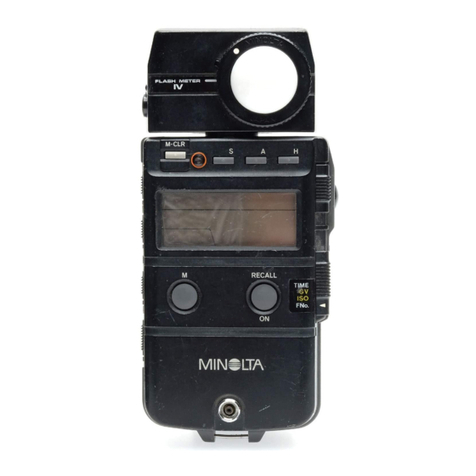
Minolta
Minolta FLASH METER IV - PART 2 manual
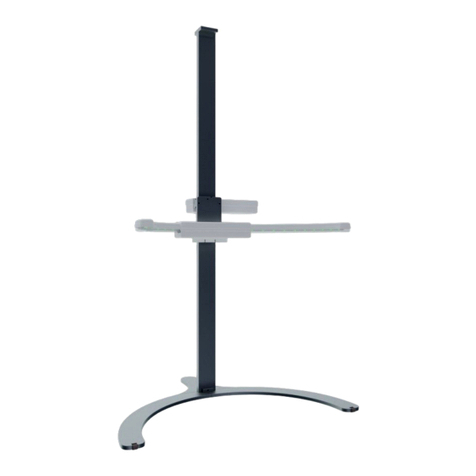
OKM
OKM BODY SCREENER user manual
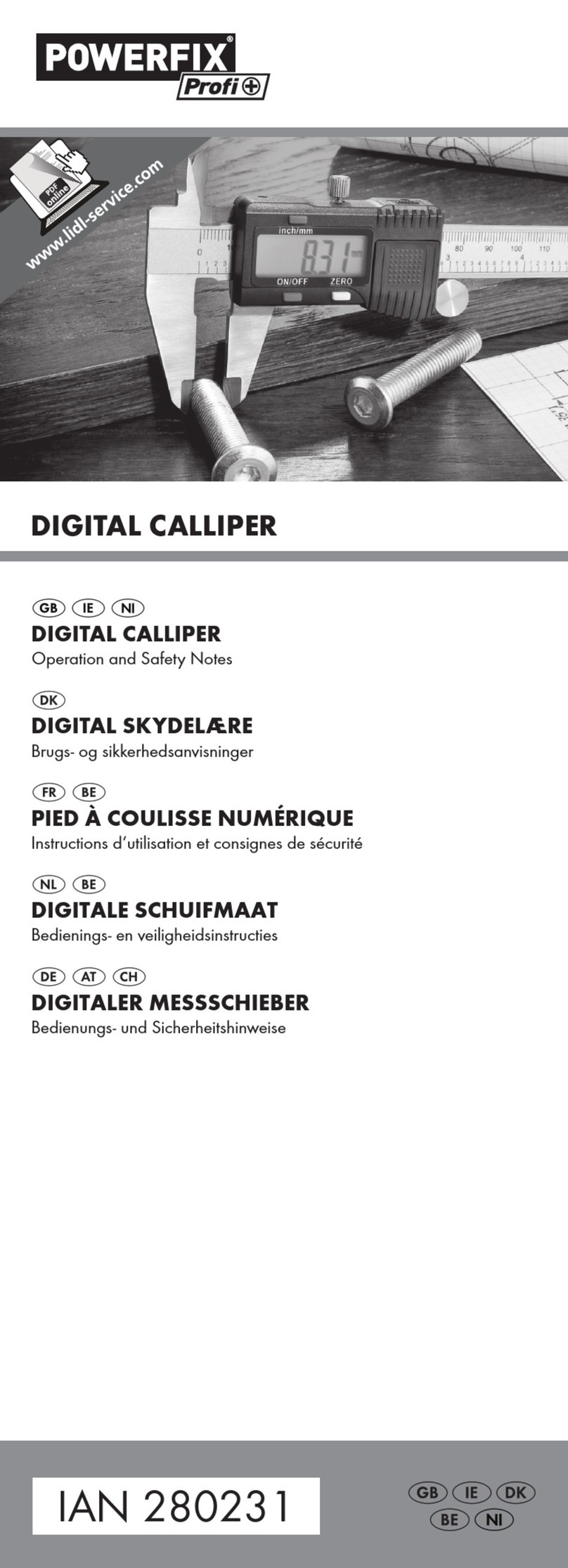
Powerfix Profi
Powerfix Profi 280231 Operation and safety notes

Kurt J. Lesker
Kurt J. Lesker Vacuum Mart KJLC 354 Series Troubleshooting

PCB Piezotronics
PCB Piezotronics IMI SENSORS 646B11 Installation and operating manual
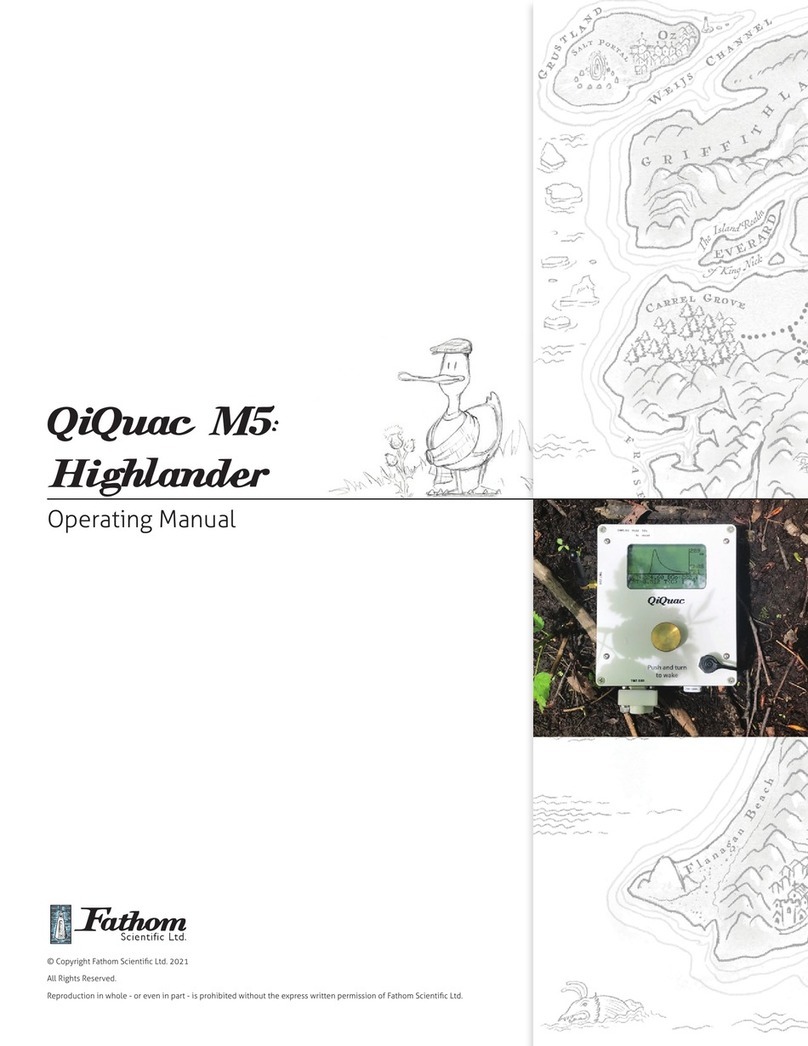
Fathom
Fathom QiQuac M5 operating manual
